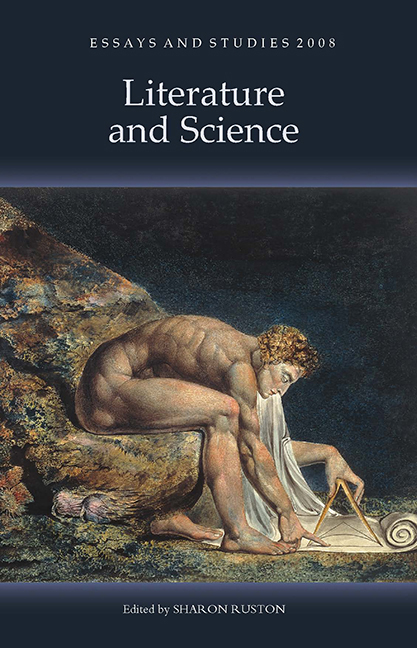Book contents
- Frontmatter
- Contents
- List of Illustrations
- Acknowledgements
- Notes on Contributors
- Introduction
- 1 From Popular Science To Contemplation: The Clouds Of The Cloud Of Unknowing
- 2 ‘Dreams And Plain Dotage’: The Value Of The Birth Of Mankind (1540–1654)
- 3 Natural Rights And Natural History In Anna Barbauld And Mary Wollstonecraft
- 4 George Eliot, Geometry And Gender
- 5 On The Back Of The Light Waves: Novel Possibilities In The ‘Fourth Dimension’
- 6 Le Fanu's ‘Carmilla’, Ireland, And Diseased Vision
- 7 Evolution, Literary History And Science Fiction
- 8 ‘The Luxury Of Storytelling’: Science, Literature And Cultural Contest In Ian Mcewan's Narrative Practice
- Index
4 - George Eliot, Geometry And Gender
Published online by Cambridge University Press: 12 February 2019
- Frontmatter
- Contents
- List of Illustrations
- Acknowledgements
- Notes on Contributors
- Introduction
- 1 From Popular Science To Contemplation: The Clouds Of The Cloud Of Unknowing
- 2 ‘Dreams And Plain Dotage’: The Value Of The Birth Of Mankind (1540–1654)
- 3 Natural Rights And Natural History In Anna Barbauld And Mary Wollstonecraft
- 4 George Eliot, Geometry And Gender
- 5 On The Back Of The Light Waves: Novel Possibilities In The ‘Fourth Dimension’
- 6 Le Fanu's ‘Carmilla’, Ireland, And Diseased Vision
- 7 Evolution, Literary History And Science Fiction
- 8 ‘The Luxury Of Storytelling’: Science, Literature And Cultural Contest In Ian Mcewan's Narrative Practice
- Index
Summary
SINCE THE PUBLICATION in the 1980s of Gillian Beer's Darwin's Plots and George Levine's Darwin and the Novelists, the map of Victorian literature has been almost wholly redrawn through critical interest in the relationships of literary and scientific writing. Very little attention indeed, however, has been given by literary scholars to the workings of mathematics in Victorian culture. This is a problematic absence from both Victorian studies and literature and science studies. It has resulted in a tendency to overemphasize the cultural impact of some scientific disciplines, and hence in a skewing of our understanding of the readership for and reception of scientific knowledge. To take one example, lack of attention to the variety and ubiquity of nineteenth-century engagements with Euclidean geometry makes us unresponsive to a wide range of metaphors, structures and key words which shape an extraordinary number of Victorian literary, political and polemical writings. Just as the Darwinian vocabulary of growth, development and inheritance can be traced in late Victorian literature whose thematic concerns are far removed from biology, the Euclidean vocabulary of proof, axiom and demonstration haunts even Victorian writing that has nothing explicitly to do with mathematics.
In this essay, however, I shall argue a more limited case, highlighting the ways in which Victorian culture ascribed contradictory, overdetermined and yet very powerful gender coding to Euclidean geometry. Because it was widely held to be a kind of knowledge that was perfect and timeless in its certainty, geometry was associated both with feminine purity and refinement and with masculine mental rigour. And because geometry was for many the epitome of a complete and fixed system of knowledge, it was often invoked to suggest the fixedness of other systems, including that of gender difference. At the same time, however, there are currents in Victorian writing about geometry which profoundly destabilize its use in the context of gender.
On 28 January 1851, a few weeks after moving to London to lodge in the publisher John Chapman's house, Marian Evans told her close friends Charles and Cara Bray that she had begun to study a new subject:
I am attending Professor Newman's course of lectures on Geometry at the Ladies’ College every Monday and Thursday.
- Type
- Chapter
- Information
- Literature and Science , pp. 72 - 90Publisher: Boydell & BrewerPrint publication year: 2008
- 4
- Cited by

